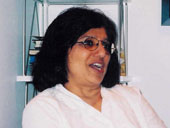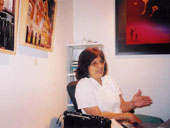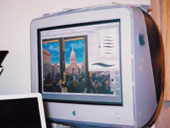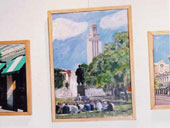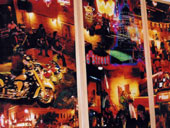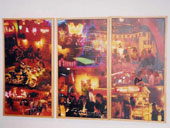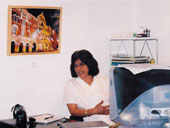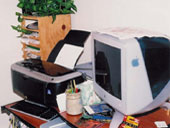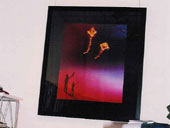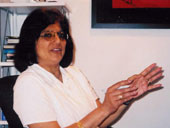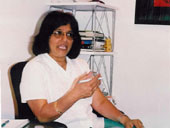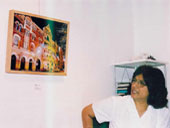Learning Library Segments
Rama Tiru
Primary Use of Medium: VisualInterviewer: Donna Wetegrove
Interview Location This interview takes place at Rama's working art studio in the Guadalupe Arts Center.
Interview Date: 8.15.03
Writer: Jenny Turney
Inspiration
Art Form/Product
Green Aspects
Marketing Values
Additional Comments
Artist Profile
Inspiration
"I'm seeing myself as an artist evolving all the time."What Type Of Artist Do You See Yourself As?
Rama says she first wanted to be painter and then went into photography. From there she rediscovered painting. "I didn't want to go back into regular painting. I wanted to tap the source that's in today so that's why I went into computer painting." She looked for ways to combine her painting with photography and bring out something new. She does this successfully with a digital medium and her photography serves as the base for every work she completes. Her final product is digital images mixed with photography.
How Did You Get Here?
"I was like a kid in a candy store and there was no structure. I experimented with everything and so I didn't focus on a particular career. I'm very happy with that."
"From the time I can remember I have always done some kind of drawing or painting from my childhood. My parents encouraged me. My Father bought me all kinds of books. And made sure I understood what I wanted to do." She looked at magazines and copied pictures she liked. From there she created her own work. Then she expressed an interest to attend art school, however it was not acceptable in India for a young girl to study art. She went on to pursue a degree in Home Economics.
After graduating she moved to England where her husband helped her enroll in formal art classes. Her courses ranged from still life painting to photography. After this she took a job in commercial photography and traveled all around the world.
After doing photography for a while, they returned to India. Here she set up a commercial studio and as she said, "did the usual commercial work" with advertising agencies. She says, " the only way I could combine my art with my photography was to do something photographically combined with fine art. That's when I experimented with light painting" Finally she figured out a way to print her pictures on canvas. At this time there was no technology to support this process. "I didn't want to paint at this timeI wanted to explore this possibility. So, I found that with digital medium I could do this and that's when I went into photography and digital. That's how it evolved."
Her parents were not to blame for her not going to art school from the beginning. In India at the time in art school, nude painting was part of the curriculum, and that was not deemed acceptable for a young girl from a middle class family in India. It was a relief for her when her husband pointed her in the direction of art courses. "It was really exhilarating," she says smiling as if she was recapturing that place in time in her mind.
Where Does Your Inspiration Come From?
"For example I wanted to do Austin's capitolI wanted to photograph it and then I looked around and found that there was a lot of work very similar." She wanted something that she personally would like to own. She describes the capitol series and explains that when you look at it (the capitol) at sunset it looks gorgeous and the richness of the architecture amazes her. "People don't notice it because there's no place to stop on the road and look around at the architecture. So that's how my capitol series got done." Her series gave the viewers a larger perspective of the capitol, as if they were viewing the capitol from a coffee shop in the middle of Congress Avenue and not rushing alongside it.
Inspiration also comes from Sixth street architecture. This series is inspired by saturated color and lights that she uses by combining photography and digital painting. "I created a whole series of the Sixth street architecture, and made it more painterlythe same with my University series." Her love of architecture definitely inspires her and is apparent in her desire to capture common scenes.
She was inspired by architecture when a friend of hers asked her to take photographs for an article he was writing for a prestigious architecture magazine. Without knowing anything about this she says, " I'm the kind of person that jumps in, looks around and then sees if I can swim. I went into that and then I found that you meet people and you see how they are in their own surroundings. It was fascinating. It made me so happy and that I could see the personality of people and link it to their homes."
That experience has stayed with her and increases her admiration of architecture.
Art Form/Product
Why Do You Like The Medium?It gives her the comfort of producing images on a tabletop environment or studio environment. She sees the results as soon as they are produced and then takes it and processes it on her own. "I don't have to depend on anyone else and I have enough expertise to get the perfect professional look that comes out of any lab. That's the reason why I choose this."
Does The Material Dictate The Design Or Does Your Design Idea Dictate How The Material Is Used?
"Yes, I push my material to the limit I've even done digital mono prints So that is another thing I am sort of exploring now; pushing it one step further."
What Brings Your Medium To Life?
"I think as far as I'm concerned the medium does not really matter, honestly, I don't think it matters at all. It's how one expresses one self and how to make the medium fit into that is what I see matters." She says, "having the most expensive camera is not going to produce the most beautiful picture anyway. And the same way with technology, if you don't know how to use it it's not going to produce the images you want." With her images, she prints them on digital medium and puts them on canvas and paints over them manually with acrylic at times. She explains that with her University series she took photographs, printed them on canvas and tried to make then one of a kind. On one particular painting she went ahead and painted the clouds instead of leaving them photographically.
What Tools Are Required In Your Process?
She uses a high-end apple computer with a high-resolution printer. She has two different printers; one for large format (24"wide x any length). She uses different cameras, a regular film-based camera one and a digital camera. "The camera I have can give me as good an image as what the large format does. So I have whatever I need for my trade and I keep looking for whatever I needthen if I need it I go and get it. To do that I have to earn the money."
As technology changes she exposes herself to new things. One thing she likes to do is go to camera stores and look at new equipment. "I don't buy clothing or fancy shoes or anything like that. Everything goes to my lenses or my inks or paper or computer equipment." To keep even more current, she uses the Internet to stay in touch with what is happening with digital medium. Her teaching position at Austin Community College keeps her thoroughly honed in to the latest as well. "When you are teaching students you learn ten times more what you would otherwise. I love the teaching and with that I am learning something."
Do You Consider It Functional Art?
"Very much so, artists and art whatever you doif it can make you come back and look at it a second time, third time, then it is functionalit is a great thing."
Please speak About The Connections.
"What medium to use depends on the subject matter more than anything else does, it's the subject matter." For example a light-painted images is pure photography. There is no digital input whatsoever. The effects of light painting and the saturation and the sparkle of light can not be enhanced without the medium being pure photography. "If I wanted to show these photographs as just photographs they would not have the same impact. I wanted them to look like painting." Sometimes the design aspect of the subject itself lends to leaving it as it is or the color aspect of it. It all makes a difference.
Please Summarize Your Entire Process.
Rama first takes photographs of the subjects that inspire her and, if it's film based, then she scans the image into her computer. If she uses a digital camera, she then plugs it in to her computer and downloads for viewing. Describing her work, she says, "I want part of it always photographicpart of the image I have to decide which part. Do I want to enhance a part or subdue the part that I want to show as photographic?" From there she decides what approach to take. If she decides a portion needs paint, she uses a stylus and tablet and paints that part. "Like a regular painter would do, I use the brush strokesto paint on the image." After this, if the subject lends itself to a watercolor kind of image she prints on watercolor paper. If oil, she prints on canvas.
The variety of the material available today is so vast that almost anything can be done. For example if Rama wants contrasting images, she can give certain areas "light likeness." Once she does this she goes back and adds special touches to make a particular piece a one-of-a-kind image. Most of the time paint is used to do this.
Do You Recommend What You Do As A Career Choice? Why?
"Yes, I do because it (what she does) tackles not only photography, but also the artistic and painterly quality." She explains that she is a painter with an artistic mind that knows how to use the technology of photography. As far as digital medium, it is still in its infancy for people that use it as a fine art medium.
"As long of one believes in themselves and keeps the quality of the work and not go too low on pricing also. Once you do people think it is worth nothing."
What Tips Might You Have For Someone New To The Medium? How Best To Develop Their Interest?
Practice. Take computer classes or photography courses. Read a lot of books and magazines. Use the Internet. "The knowledge of technology is a great art. Be artistic; don't compromise on your artistry. Practice makes it perfect."
Green Aspects
Please Point Out Any "Green" Aspects Of Your Process And Your Medium.Her process does not put out any toxic chemicals that spoil the environment, since light is the main component. "I don't have processing chemicals. No fumes. It's all very safe environmentally and still creates beauty to the world we live in."
Marketing Values
Please Talk About Making Multiples Of A Creative Effort As A Part Of Your Business.She only prints ten copies of each work. That is her choice, however she says if the buyer wants a one of a kind pieces of artwork, she destroys the image.
For her digital work, she explains that, "people have this inhibition about digital images...they think it is mass-produced and not of value. I would disagree strongly." She says it is the artist's decision to mass-produce a piece of work. The work still has value and can still be exclusive. "Digital is here to stay," she says and says in any form the value does not lessen. "People need to accept it as a medium today and use it."
She uses the Guadalupe Arts Center to stay connected with other artists and to display her works. Her web site serves as a marketing vehicle for online purchases.
Where Do You See Your Creativity Evolving?
"I think I'm a growing person all the time. I can't say I've reached a plateau or a pinnacle. If there is something more to do, I'll do it. I'm going to do addendum not a different project."
Additional Comments
She says if you are interested in doing what she does, to photograph interiors and architecture, use various types of software and understand all that is available to you.She teaches at ACC and can be found in the course catalog in the photography department. She teaches Digital Imaging in relation to photography. She is more than happy to talk to anyone about her experience, artwork and career.
Artist Profile:
Rama Tiru1705 Guadalupe Street
Austin, TX 78701
Phone: 512-346-2976
Email:
Website: www.ramatiru.com
Thank you for utilizing TIPS On Art Learning Segments On The Web to further your understanding of the process of artists and art forms. Please take a few minutes to fill out our website survey. Through your feedback, and by making special requests of us for future segments, we will know how TIPS On Art has impacted your situation.

